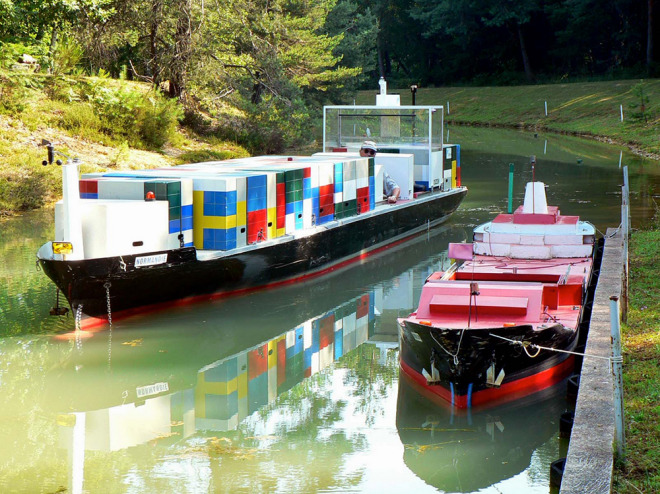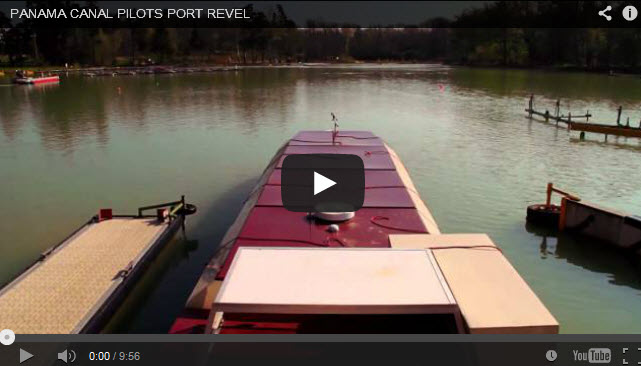At the Port Revel ship-handling school, pilots practice on 1:25 scale model boats.  courtesy Port Revel.
courtesy Port Revel.
Sailing the Panama Canal is tricky. The journey between the Pacific Ocean and Caribbean Sea can take ten hours and involves navigating through a series of locks and waterways, and it’s best left to professionals. That’s why every ship crossing the famous waterway—from a retired couple’s pleasure yacht or a 900-foot container ship that fits with just inches to spare—is placed under the control of a member of the Panama Canal Pilots Association.
Those pilots will soon be tasked with navigating significantly larger vessels in a new environment, once the expansion of the 100-year-old canal is complete. The $6 billion project, on track for completion in 2016, will result in a new set of locks, deeper and wider channels, and the use of tugboats to nudge ships into locks, instead of electric locomotives running on tracks. The new setup will allow bigger ships (and more trade) to pass from one side of the continent to the other, but presents a challenge for pilots used to guiding vessels of a particular size a particular way.
To train pilots to maneuver so-called Post-Panamax ships through the canal’s reconfigured waterways, the Panama Canal Pilots Association is sending some of its members to an unlikely location: the French Alps.
Port Revel, near Grenoble, is one of the few facilities in the world devoted to ship handling on a miniature scale. Maritime pilots and captains have been coming to the school since it opened in 1967, drawn by the opportunity to practice skills in a way that’s more real than a computer simulator and less dangerous than taking control of a 70,000-ton ship with a stopping distance measured in miles. Port Revel’s oil tankers, container ships, cruise ships, and tugboats are meticulously crafted 1:25 scale models, complete with helm, electric engine, bow and stern thruster controls, mooring lines, and operational anchors.
They train on a 13-acre, man-made lake that comes with generated waves and wind.  courtesy Port Revel
courtesy Port Revel
Steering one of the miniature vessels on the school’s 13-acre, manmade lake mimics the feeling of being on a full-size boat, since the pilot on board is sitting at the level of the bridge, just as he would in real life. Ship handling courses at Port Revel typically last five days, with mornings consisting of indoor lectures and afternoons spent on the water. The school even has a replica of a lock that will be part of the reworked canal.
The instructors—maritime pilots themselves—provide real-time feedback in a mixture of French and English as students practice a variety of maneuvers. They use wave and wind generators to replicate real world conditions. “We concentrate particularly on ship handling in shallow waters, with currents, and in emergencies, for example mechanical failures of the engine and or rudder,” says Arthur de Graauw, Port Revel’s director.
Port Revel will soon have some competition. The Panama Canal Authority is building its own, new maritime training center in Panama, which will include a lake and 1:25 scale vessels. “At this time we have selected the area and plans for construction are being made,” says Peter Pusztai, supervisor of the training unit of Marine Simulation, Maritime Research and Development for the Authority. “The lake will contain the Culebra Cut [a narrow waterway in the canal] to scale with one lake at each end, with their respective locks with two chambers and harbors.” Training with a model of this notoriously tricky part of the canal will enable pilots to test if two Post-Panamax ships can safely cross the expanded Culebra Cut simultaneously in opposite directions, which canal officials are suggesting is possible. So the men and women plying the waters of the canal may not all get a trip to France, but at least they’ll be prepared for the challenge.


